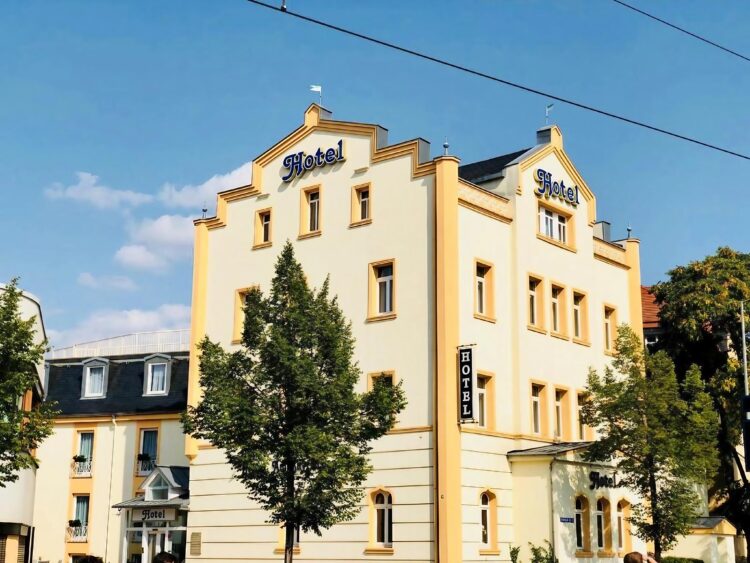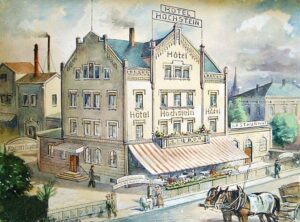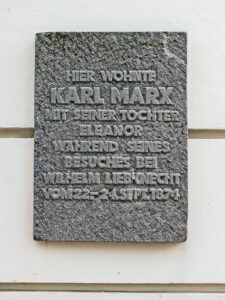Origin at Bayerischer Bahnhof
Join us on an exciting journey through three centuries. To understand the history of the Hotel am Bayrischen Platz, one must start at the Bayerischer Bahnhof (Bavarian Railway Station). With its opening in the mid-19th century, the south of Leipzig became the gateway to Bavaria and Bohemia – and it was here, on today’s Bayrischer Platz, that merchant Georg Müller built an inn in 1862, offering travelers accommodation, cuisine, and conviviality near the tracks. From its convenient location, a house developed that grew with the district over generations and reflected its changes.
From the Inn to the “Hotel Hochstein”
As early as 1875, the establishment operated as the Hotel Hochstein – named after its owner Louis-Ferdinand Hochstein. The establishment was not only accommodation for travelers but also a bourgeois meeting place with a wine bar, garden restaurant, and halls for gatherings. During this period, the district became denser, Leipzig expanded, and the hotel adapted to the new urban environment: more representative in appearance, more comfortable inside, without abandoning its functional proximity to the train station.
A Prominent Moment: Karl Marx in Leipzig
A chapter that made the house’s history known beyond the city dates back to September 1874. Karl Marx stayed here together with his daughter Eleanor during a stay in Leipzig – a brief entry in the philosopher’s biography, but a formative anchor of remembrance for the house. A plaque at the hotel commemorates this moment. Would you like to stay in the Karl Marx Room? Simply contact the hotel directly to learn more.
Late Classicist Lines – from Townhouse to City Hotel
The building itself is a late Classicist urban structure, typical of Leipzig’s southern suburbs: clear facade axes, pilaster strips for vertical articulation, a strong cornice as a finish, and a restrained gable in the roof zone. The construction foregoes historicist opulence and instead relies on proportion and order – qualities that are also palpable inside: high ceilings, generous window formats, well-lit staircases, and floor plans that cleverly interlink hospitality, social rooms, and lodging. These civil, urban virtues define the character of the house to this day.
Between War, Post-War Period, and HO Era
The first half of the 20th century left its mark – as everywhere in Leipzig. War years, post-war scarcity, and municipal management shaped its use and appearance. The hotel remained a place of arrival, albeit with changing ownership and responsibilities. The fact that the building survived the times is due to its robust construction and the fact that it was always needed – as a hostel, as a restaurant, as a local point of reference in the square.
Renovation and Heritage Protection
In the 1990s, the existing structure once again came into sharper focus. Heritage-conscious renovations secured the structure and shell, opened up bricked-up sections, and once again highlighted the facade’s order. Inside, plumbing, fire protection, and bathrooms were brought up to modern standards – carefully enough to preserve historical room heights, door formats, and parts of the wooden furnishings. The building’s heritage protection status is not a mere decorative label but a commitment: it preserves the urban memory of a Leipzig hotel tradition that is rooted long before modernity.
Style in Detail: Proportion, Material, Atmosphere
Standing before the facade, one recognizes the classic tripartite division: a plinth zone with a public ground floor, a calm central section with regularly spaced window axes, and a clear upper finish. The materials – plastered surfaces, natural stone for plinth and jamb accents, later supplemented zinc and slate sections in the roof – appear restrained. Inside, staircases with wooden handrails, stucco-free but elegant ceiling heights, and wide corridors translate the promise of the facade: nothing is theatrical, much is measured. It is precisely this understated quality that makes the house so appealing – a city hotel that provides the stage for the city without having to pose itself.
Present with History
Today, the house consciously bears its historical name Hotel am Bayrischen Platz. It recalls the traveler’s DNA at Bayerischer Bahnhof and the bourgeois hospitality that shaped Leipzig’s south. Those who stay here experience architecture that was not historicized retrospectively, but tells its own story: of arrival and departure, of urban expansion and bourgeois everyday life, of a Leipzig that has been growing and reorganizing itself since the 19th century.
A Piece of Leipzig, Built to Last
The Hotel am Bayrischen Platz is less a single event in architectural history and more a permanent urban motif: a house that breathes with the city, that preserves its late Classicist language and has simultaneously absorbed all phases of use. Whoever looks at its history sees the modernity of the city in miniature: mobility, trade, conviviality – bundled in a building that radiates permanence. Precisely therein lies its value: history to check into, without pathos, but with character.




